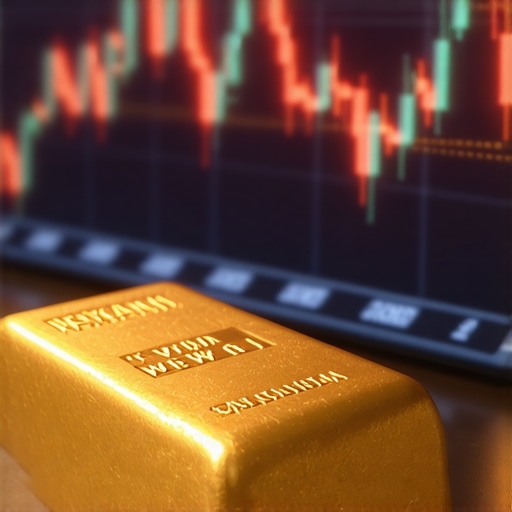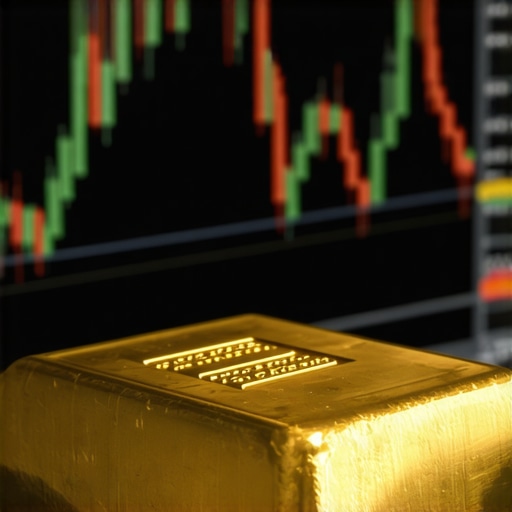Unlocking the Future: Why 2025 Could Be a Pivotal Year for Gold Prices
As we approach 2025, investors worldwide are scrutinizing the complex economic tapestry that will influence gold price trajectories. Far beyond mere speculation, understanding the core economic drivers—from inflationary pressures to geopolitical tensions—can empower you to navigate the gold market with strategic foresight. The allure of gold as a timeless safe haven is well-known, but the nuanced interplay of global trends makes the upcoming years uniquely challenging and opportune.
Inflation and Interest Rates: The Twin Engines Steering Gold’s Market Value
Historically, gold has thrived amid rising inflation and fluctuating interest rates. With central banks worldwide grappling with inflation targets and monetary tightening, 2025 could witness significant price movements. When real interest rates dip below zero, gold’s appeal as a non-yielding asset surges, offering a hedge against eroding purchasing power. Investors should watch the Federal Reserve’s policy shifts closely; even subtle adjustments can recalibrate gold demand dramatically.
Supply Constraints and Demand Dynamics: The Hidden Forces Behind Gold Price Swings
Gold’s supply-demand equilibrium is under constant pressure from mining outputs, recycling rates, and evolving industrial needs, particularly in technology and jewelry sectors. Moreover, central banks’ strategic gold acquisitions are reshaping the market balance. Understanding these forces is critical; for example, a tightening supply amid robust demand from emerging economies could catalyze upward price momentum. Deep insights into these trends are available in analyses like gold supply and demand essential insights.
How Do Geopolitical Risks Influence Gold Prices in 2025?
Geopolitical tensions—ranging from trade conflicts to regional instabilities—tend to amplify gold’s role as a safe haven. In 2025, uncertainties such as shifting alliances, sanctions, and conflict zones could inject volatility into financial markets, prompting a flight to gold. The metal’s unique status as a store of value during crises underscores the importance of monitoring global political developments as part of any investment strategy.
Technological Innovations and Their Surprising Impact on Gold Demand
Beyond traditional uses, gold’s importance in cutting-edge technologies like electronics, medical devices, and green energy solutions is expanding. These sectors drive incremental demand that can subtly influence prices over time. Investors attuned to these trends can anticipate shifts in industrial gold consumption that conventional analyses might overlook.
Integrating Gold Into a Balanced Portfolio: Strategic Moves for 2025
Given the multifaceted economic landscape, diversifying investment portfolios with gold—whether through physical bullion, ETFs, or mutual funds—can offer risk mitigation and steady returns. For practical guidance on balanced portfolio construction, explore resources such as how to create a balanced portfolio with gold ETFs and stocks. Tailoring your gold exposure to your risk tolerance and market outlook remains paramount.
Understanding these economic trends is not merely academic; it’s a critical step toward making informed, confident investment decisions. If you found these insights valuable, consider sharing this article with your network or leaving a comment to discuss your perspective—your engagement enriches the conversation.
For authoritative perspectives on gold’s role in the economy, consider reviewing reports by the World Gold Council, a leading source on global gold market analysis (World Gold Council – Gold Demand Trends).
Why Timing and Market Sentiment Matter More Than Ever
Reflecting on my own journey with gold investments, I’ve realized that timing isn’t just about catching the right moment but also understanding the mood of the market. For instance, during a period of geopolitical unrest, I noticed a surge in gold prices that wasn’t entirely explained by fundamental economic data alone—it was the collective anxiety and uncertainty that drove demand. This taught me that alongside economic indicators, tracking market sentiment and news cycles is crucial to making smarter decisions.
Learning from Experience: Navigating Volatility with Patience and Research
Early in my investing career, I was tempted to react impulsively to price swings, but over time, patience paired with thorough research became my best allies. I found that volatility, while intimidating, often presents unexpected buying opportunities if you understand the underlying supply and demand dynamics. For example, during a recent dip, insights from resources like analyzing global gold demand trends and price impacts helped me identify when the fundamentals remained strong despite short-term price drops.
How Can You Balance Emotional Investing with Data-Driven Decisions?
This question often comes up when I chat with fellow investors. The key, I believe, is to cultivate a mindset that respects both your intuition and the hard data. It’s natural to feel anxious during market dips, but stepping back to analyze supply constraints, central bank behaviors, and technological demand for gold can ground your choices. Tools like detailed market reports and gold price forecasts become invaluable to keep emotions in check.
The Role of Digital Innovations in Gold Investment Strategies
Another fascinating development I’ve observed is the rise of digital gold platforms and ETFs, which offer accessibility and liquidity that traditional physical gold sometimes lacks. While I still hold physical gold for its tangibility and security, integrating ETFs in my portfolio has allowed me to diversify and respond quickly to market changes. If you want to explore how to create a balanced portfolio that includes both physical and digital gold assets, check out this guide on portfolio creation.
Sharing and Learning: Your Experiences Matter
Investing in gold is as much about community as it is about strategy. I’d love to hear about your own experiences, challenges, or tips when it comes to gold investing—whether it’s about spotting trends, choosing between physical and digital gold, or navigating the emotional rollercoaster. Feel free to share your stories in the comments below or explore related topics like smart gold investment strategies for inflation protection to deepen your understanding.
Decoding Market Sentiment: Leveraging Behavioral Finance to Forecast Gold Price Fluctuations
Market sentiment often acts as an invisible hand influencing gold prices beyond traditional economic indicators. Behavioral finance reveals that investor psychology—driven by cognitive biases like herd behavior, loss aversion, and confirmation bias—can precipitate sharp price movements. In 2025, as global uncertainties persist, understanding these psychological drivers offers a competitive edge. Employing sentiment analysis tools and monitoring social media trends alongside macroeconomic data enables investors to anticipate speculative spikes or troughs in gold prices more effectively.
Advanced Hedging Techniques: Combining Options, Futures, and Physical Gold for Risk Mitigation
For sophisticated investors, merely holding physical gold or ETFs may not suffice to manage portfolio risk optimally. Utilizing derivatives such as options and futures contracts can provide tailored hedging strategies against volatility and inflationary risks. For example, purchasing gold call options allows exposure to upside potential with controlled downside, while futures contracts can lock in prices during anticipated supply squeezes. Integrating these instruments requires deep expertise but can substantially enhance portfolio resilience in the face of 2025’s anticipated market swings.
What Are the Implications of Central Bank Digital Currencies (CBDCs) on Gold Demand?
The emergence of CBDCs introduces a nuanced dynamic to gold investment strategies. While CBDCs promise enhanced liquidity and transparency in monetary systems, they could also alter traditional safe-haven flows by providing a digital alternative to physical assets. Investors must analyze whether CBDCs will complement or compete with gold’s role as a store of value. Early evidence suggests a complex interaction where CBDCs might reduce gold demand in transactional contexts but reinforce it as a hedge against digital currency system risks.
Quantitative Models and AI-Driven Forecasting: The Next Frontier in Gold Price Prediction
Cutting-edge quantitative models employing machine learning algorithms and natural language processing are reshaping how analysts forecast gold prices. By ingesting vast datasets—from economic indicators and geopolitical news to social sentiment and supply chain analytics—AI-driven platforms can detect subtle patterns invisible to human analysts. Investors leveraging these technologies gain access to probabilistic forecasts with higher accuracy, enabling proactive portfolio adjustments. Exploring such advanced tools is becoming indispensable for those targeting alpha in the rapidly evolving 2025 gold market landscape.
Environmental, Social, and Governance (ESG) Considerations in Gold Mining and Investment
ESG criteria are increasingly integral to gold investment decisions. Responsible mining practices, labor standards, and environmental impact now influence the valuation and desirability of gold assets. Investors prioritizing ESG-compliant gold sources may face premium costs but benefit from lower reputational and regulatory risks. Moreover, funds and ETFs with ESG mandates are attracting greater inflows, potentially shifting demand patterns. Staying informed about ESG developments in the gold sector is crucial for aligning investments with emerging global sustainability standards.
Understanding these sophisticated layers of gold market dynamics elevates your investment strategy from reactive to anticipatory. For deeper dives into AI-based gold price forecasting models, consider reviewing research by the National Bureau of Economic Research on commodity price prediction using machine learning. I encourage you to engage with this evolving discourse—share your thoughts or questions below and explore our advanced guides to refine your gold investment acumen further.
Harnessing Behavioral Finance for Predictive Gold Market Strategies
Behavioral finance has unveiled profound insights into how investor psychology shapes gold price movements beyond fundamental economic data. Concepts such as herd mentality, loss aversion, and anchoring bias can trigger exaggerated market reactions during periods of uncertainty. In 2025’s volatile landscape, sophisticated investors are employing sentiment analysis tools that scrutinize social media chatter, news sentiment, and trading volumes to anticipate speculative surges or corrections in gold prices. This advanced understanding of collective investor behavior complements quantitative models, enabling more nuanced entry and exit strategies.
Integrating AI-Powered Forecasting Models for Enhanced Market Timing
Artificial intelligence and machine learning have revolutionized commodity price forecasting by processing multifactorial datasets encompassing macroeconomic indicators, geopolitical developments, and alternative data streams. These AI-driven models detect latent correlations and nonlinear patterns that traditional econometric methods might overlook. For instance, natural language processing algorithms analyze real-time geopolitical news to assess potential market shocks impacting gold demand. By incorporating probabilistic forecasts generated from ensemble learning techniques, investors can optimize portfolio allocation with greater confidence and agility.
How Can Investors Effectively Combine Behavioral Insights and AI Forecasting in Gold Investment Decisions?
Effectively merging behavioral finance insights with AI-powered forecasts requires a hybrid analytical framework. Investors should juxtapose quantitative predictions with qualitative assessments of market sentiment to validate signals. For example, an AI model might forecast an upward trend based on supply-demand imbalances, but heightened negative sentiment detected through social media analysis may signal an impending short-term correction. Developing dashboards that integrate sentiment indices alongside AI predictions facilitates dynamic decision-making, reducing reactionary errors driven by cognitive biases.
Environmental, Social, and Governance (ESG) Trends Reshaping Gold Mining and Investor Preferences
ESG considerations are no longer peripheral but central to gold investment paradigms. Mining companies adhering to stringent environmental stewardship, community engagement, and transparent governance attract premium valuations and preferred access to capital. Consequently, ESG-compliant gold assets are increasingly favored by institutional investors and ESG-focused funds, influencing demand trajectories. Monitoring ESG rating evolutions and regulatory frameworks enables investors to anticipate shifts in gold supply dynamics and potential cost implications stemming from sustainable mining practices.
Expert Resource Spotlight: National Bureau of Economic Research on AI in Commodity Markets
For a rigorous exposition on the application of machine learning in commodity price prediction, including gold, the National Bureau of Economic Research provides seminal research papers. Their study “Commodity Price Prediction Using Machine Learning” offers empirical evidence on model performance enhancements and practical implementation considerations, underscoring the transformative potential of AI in investment strategies.
Engage with the Future of Gold Investing: Embrace these cutting-edge analytical tools and behavioral insights to elevate your investment approach. Share your experiences or questions below and explore our advanced guides to refine your expertise in navigating the complex 2025 gold market.
Frequently Asked Questions (FAQ)
What factors will primarily drive gold prices in 2025?
Gold prices in 2025 will be influenced by a complex mix of inflation rates, real interest rates, geopolitical tensions, supply-demand imbalances, and technological demand. Central bank policies and emerging ESG considerations will also play crucial roles, making it essential to monitor both macroeconomic indicators and market sentiment.
How do geopolitical risks impact gold’s safe-haven status?
Geopolitical risks typically increase uncertainty in financial markets, prompting investors to seek safety in gold. In 2025, trade conflicts, regional instabilities, and shifting alliances could heighten volatility, reinforcing gold’s role as a crisis hedge and potentially driving prices upward.
Can AI and machine learning improve gold price forecasting accuracy?
Yes, AI-driven models leverage multifaceted data—including economic indicators, news sentiment, and supply chain analytics—to identify patterns traditional models might miss. These tools provide probabilistic forecasts that enable investors to anticipate trends and adjust portfolios proactively.
What role does behavioral finance play in gold investment strategies?
Behavioral finance examines how cognitive biases and investor psychology influence market movements. Understanding phenomena like herd behavior and loss aversion helps investors interpret market sentiment, complement quantitative analysis, and avoid emotionally driven decisions during volatile periods.
How can investors integrate ESG considerations when investing in gold?
Investors can prioritize gold sourced from companies adhering to environmental, social, and governance standards. ESG-compliant gold assets often carry premiums but reduce reputational and regulatory risks. Monitoring ESG ratings and investing in ESG-focused funds can align portfolios with sustainability goals and emerging market trends.
What are advanced hedging strategies involving gold?
Beyond physical gold and ETFs, investors can use derivatives like options and futures to hedge against volatility and inflation. These instruments allow tailored risk management, such as locking in prices or controlling downside exposure while retaining upside potential.
How might Central Bank Digital Currencies (CBDCs) affect gold demand?
CBDCs may alter traditional safe-haven flows by providing digital alternatives to physical gold in transactions. However, they could also reinforce gold’s hedge function against potential risks in digital currency systems. The net effect is complex and warrants close observation as CBDCs evolve.
What are the benefits of combining behavioral insights with AI forecasting?
Combining these approaches creates a more holistic analytical framework. AI models offer data-driven trend predictions, while behavioral insights provide context on market sentiment and potential emotional overreactions. This synergy enhances timing and decision-making precision.
Is physical gold still relevant compared to digital gold platforms?
Physical gold offers tangibility, security, and a direct store of value, whereas digital platforms and ETFs provide liquidity and ease of trading. A balanced portfolio often includes both, leveraging the strengths of each to optimize flexibility and risk management.
How important is timing in gold investment amidst market volatility?
Timing is critical but should be informed by a comprehensive understanding of economic indicators, sentiment analysis, and supply-demand fundamentals. Reacting impulsively to price swings can lead to missed opportunities or losses, whereas strategic timing enhances portfolio resilience.
Trusted External Sources
- World Gold Council – Offers authoritative data and analysis on global gold supply, demand trends, and investment insights, essential for understanding market fundamentals.
- National Bureau of Economic Research (NBER) – Provides seminal research on AI and machine learning applications in commodity price forecasting, including gold, enhancing understanding of advanced analytical approaches.
- Bank of England Research on Digital Currencies – Examines the implications of Central Bank Digital Currencies on gold demand and monetary systems, offering critical perspectives on emerging financial technologies.
- International Council on Mining and Metals (ICMM) – Focuses on ESG standards in mining practices, helping investors evaluate sustainable gold sourcing and associated risks.
- Behavioral Finance Journals (e.g., Journal of Behavioral Finance) – Publish research on investor psychology and market sentiment, providing insights into the behavioral drivers behind gold price fluctuations.
Conclusion
As 2025 approaches, the gold market stands at the crossroads of traditional economic forces and rapidly evolving innovations. Inflation dynamics, geopolitical uncertainties, and supply-demand shifts continue to underpin gold’s enduring appeal, while AI-driven forecasting and behavioral finance insights offer unprecedented tools to navigate volatility. Moreover, ESG considerations and digital monetary developments add new layers of complexity and opportunity. By synthesizing these multifaceted factors, investors can strategically position gold within diversified portfolios to harness its hedge and growth potential. Embracing a balanced approach—integrating physical assets, digital instruments, advanced analytics, and a keen understanding of market sentiment—will be paramount to capitalizing on gold’s future trajectory. Share your perspectives, engage with expert resources, and explore our comprehensive guides to deepen your mastery of gold investing in the dynamic landscape ahead.










The post does a great job highlighting how multifaceted the gold market will be in 2025, especially with inflation and geopolitical risks influencing prices. From my experience, timing has truly been a challenge—not just reading economic data, but also understanding the emotional undercurrents that drive market behavior. For instance, during times of geopolitical tension, gold price spikes seemed driven more by anxiety than immediate economic changes. Integrating sentiment analysis with fundamental data, as suggested here, feels like an essential next step for any investor wanting to navigate such volatility effectively. I’m curious about how others incorporate emerging technologies, like AI forecasting, into their real-world decision-making? Do you rely more on quantitative models, or are personal judgment and market sentiment still your primary guides? Also, with ESG considerations gaining traction, how are people balancing ethical concerns with traditional investment goals when selecting gold assets? I wonder if paying a premium for ESG-compliant gold has meaningfully impacted portfolio performance or risk in practice.